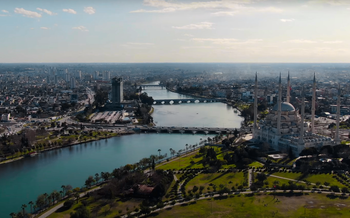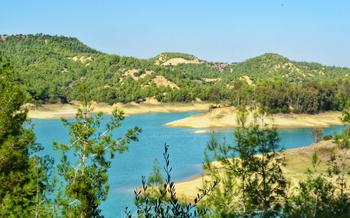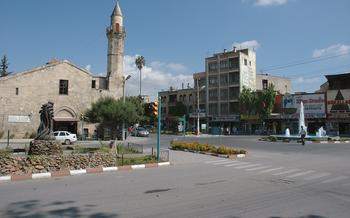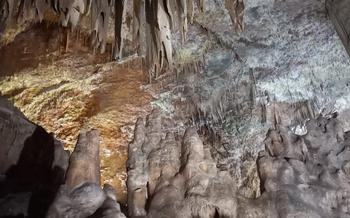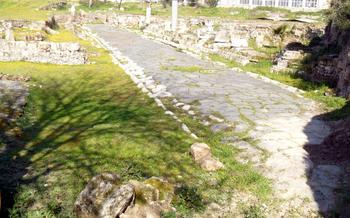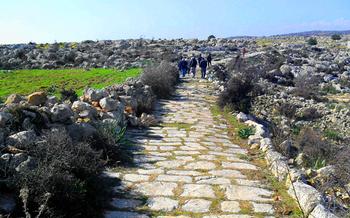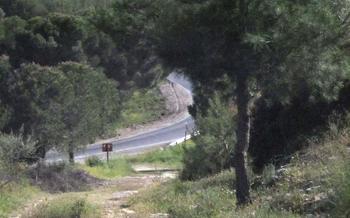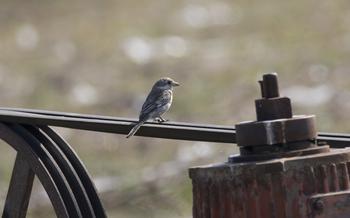
Eshab ı Kehf Cave
- Eshab-ı Kehf Cave: A Mysterious and Sacred Site
- Location and Accessibility
- Natural Beauty and Surroundings
- Exploring the Cave
- Historical and Cultural Significance
- The Seven Sleepers Legend
- Religious Significance and Pilgrimage
- Archaeological Discoveries and Excavations
- Local Cuisine and Delicacies
- Accommodation and Lodging Options
- Best Time to Visit
- Photography and Videography
- Guided Tours and Local Guides
- Safety and Precautions
- Insider Tip: Hidden Gems and Secret Spots
Eshab-ı Kehf Cave: A Mysterious and Sacred Site
Nestled in the heart of Mersin, Turkey, the Eshab-ı Kehf Cave stands as a testament to history, legend, and religious significance. Its name, meaning "Companions of the Cave," echoes the ancient tale of the Seven Sleepers, whose story has captivated imaginations for centuries.
The cave's allure stems from its mysterious past and sacred associations. According to Islamic and Christian traditions, it was here that seven pious youths sought refuge from persecution, falling into a deep sleep that lasted for centuries. Upon awakening, they found themselves in a transformed world, their story serving as a reminder of faith, patience, and divine intervention.
Over the centuries, the cave has become a pilgrimage site for believers seeking spiritual enlightenment and connection with the divine. Its sacred aura attracts visitors from all walks of life, drawn to its serene atmosphere and the opportunity to walk in the footsteps of history. Archaeological excavations conducted at the site have unearthed numerous artifacts and inscriptions, shedding light on ancient civilizations and the cave's enduring significance.
Location and Accessibility
The Eshab-ı Kehf Cave is situated in the picturesque Tarsus district of Mersin, Turkey. Nestled amidst the rugged Taurus Mountains, it lies approximately 20 kilometers northeast of the city center. To reach this hidden gem, visitors can embark on a scenic drive along the winding roads that traverse the mountainous landscape. Alternatively, public transportation options are available, with regular buses departing from Mersin to Tarsus and nearby villages. The cave is conveniently located a short distance from other prominent attractions in the region, such as the ancient city of Soli-Pompeiopolis and the majestic waterfalls of Çatalan. Whether you choose to drive or take public transport, the journey to Eshab-ı Kehf Cave promises breathtaking views and a memorable experience.
Natural Beauty and Surroundings
The Eshab-ı Kehf Cave is not only a sacred and historical site but also a natural marvel. The unique geological formations and cave structure create a breathtaking spectacle. The cave's interior is adorned with intricate cave systems, chambers, and tunnels, each offering a different experience. Visitors can explore these hidden wonders and marvel at the stalactites and stalagmites that have been shaped over millennia.
The surrounding landscape provides a stunning backdrop to the cave. Lush greenery, forests, and Mediterranean flora envelop the area, creating a serene and tranquil environment. The cave's location on a hilltop offers panoramic views of the surrounding countryside, allowing visitors to soak in the beauty of the natural world. The rich biodiversity of the region attracts a variety of wildlife, including birds, butterflies, and small mammals, adding to the charm of the site.
Exploring the Cave
Venturing into the Eshab ı Kehf Cave is an awe-inspiring experience that transports visitors back in time. Its intricate cave systems and chambers, formed by millennia of erosion, reveal a subterranean world of natural wonders. As you delve deeper into the cave, you'll encounter ancient inscriptions and historical artifacts that provide glimpses into the lives of those who once sought refuge within these hidden depths.
The cave's interior structure is a testament to the power and artistry of nature. Stalactites and stalagmites, formed by the slow drip of water over countless centuries, create a captivating display of natural sculptures. The walls are adorned with intricate patterns and textures, each telling a unique story of geological processes.
While exploring the cave, it's important to prioritize safety. Proper lighting is essential for navigating the dimly lit passages, and sturdy footwear will provide traction on uneven surfaces. Visitors should also be aware of potential hazards such as slippery rocks and narrow passages.
For those seeking a more in-depth exploration, guided tours are available to provide insights into the cave's history, geology, and significance. These tours are led by experienced guides who can safely lead visitors through the cave's intricate chambers and share fascinating stories about the cave's past inhabitants.
Historical and Cultural Significance
The Eshab-ı Kehf Cave holds immense historical and cultural significance, serving as a testament to the area's rich past and ancient civilizations. Excavations conducted at the site have unearthed artifacts and remains that provide valuable insights into the lives and practices of our ancestors. Archaeological evidence suggests that the cave was inhabited as early as the Neolithic period, with traces of human presence dating back thousands of years. Over time, the cave became a sacred site for various cultures and religions, each leaving its mark on the cave's history and lore. The cave's association with the legend of the Seven Sleepers has further contributed to its cultural significance, making it a popular destination for pilgrims and history enthusiasts alike.
The Seven Sleepers Legend
The Eshab-ı Kehf Cave is deeply intertwined with the legend of the Seven Sleepers, a captivating tale that has been passed down through generations. The story recounts the journey of seven pious young men who sought refuge in a cave during a time of religious persecution. As they slumbered, time stood still, and they remained in a deep sleep for centuries.
According to the legend, the sleepers were awakened by a shepherd boy named Kıtmir, who stumbled upon their cave while searching for a lost sheep. Upon entering the cave, the shepherd discovered the seven young men, their bodies miraculously preserved, as if time had not touched them.
The legend of the Seven Sleepers holds profound symbolism and has been interpreted in various ways. It represents the power of faith, the transience of time, and the enduring nature of truth. It also serves as a reminder of the importance of seeking refuge and protection in times of adversity.
The story of the Seven Sleepers has been depicted in numerous works of art and literature throughout history. It has been immortalized in paintings, sculptures, and tapestries, each capturing the essence of the legend and its timeless message. The tale continues to be a source of inspiration and wonder for people of all ages and cultures.
Religious Significance and Pilgrimage
The Eshab-ı Kehf Cave holds profound religious significance, attracting pilgrims from various faiths and backgrounds. According to Islamic tradition, the cave served as a refuge for the Seven Sleepers, a group of pious youths who sought refuge in the cave during a period of persecution. The legend narrates that they fell into a deep slumber for centuries, awakening at a time when religious tolerance prevailed. This story is revered and remembered as a symbol of patience, faith, and divine protection.
As a result, the cave has become a sacred site for Muslims, who visit to pay homage and seek blessings. Pilgrims perform rituals, offer prayers, and engage in spiritual practices within the cave, creating an atmosphere of reverence and devotion. The cave's religious significance has transformed it into a place of pilgrimage, drawing individuals seeking solace, guidance, and a deeper connection with their faith. Facilities and accommodations have been developed to cater to the needs of pilgrims, ensuring a comfortable and fulfilling experience during their visit.
Archaeological Discoveries and Excavations
Extensive archaeological excavations have been conducted at the Eshab-ı Kehf Cave site, revealing a wealth of artifacts and remains that provide valuable insights into ancient civilizations and their way of life. These excavations have uncovered evidence of human habitation dating back to the Neolithic period, suggesting that the cave has been a significant site for thousands of years.
Among the most notable discoveries are ancient pottery fragments, stone tools, and jewelry, indicating the presence of early settlements in the area. Furthermore, inscriptions and carvings on the cave walls have provided researchers with clues about the beliefs and practices of these ancient inhabitants.
In addition, excavations have revealed the remains of a Byzantine church, suggesting that the cave was also used as a place of worship during the early Christian era. These findings highlight the continuity of religious significance associated with the cave throughout history.
Ongoing research and archaeological projects continue to shed light on the rich history and cultural heritage of the Eshab-ı Kehf Cave. By studying the artifacts and remains discovered at the site, archaeologists aim to reconstruct the lives and traditions of the ancient civilizations that inhabited this sacred and enigmatic place.
Local Cuisine and Delicacies
Mersin, renowned for its rich culinary heritage, offers a delectable array of dishes that tantalize the taste buds. As you venture to explore the Eshab-ı Kehf Cave, immerse yourself in the local gastronomic delights that await. Indulge in the aromatic flavors of tantuni, a traditional Mersin dish consisting of grilled meat, vegetables, and spices, wrapped in a thin and crispy flatbread. Savor the freshness of mevlana, a vibrant salad made with tomatoes, cucumbers, onions, and parsley, drizzled with a zesty lemon dressing. Tantalize your palate with cevizli sucuk, a sweet and savory sausage made from walnuts, spices, and grape molasses. Don't miss the opportunity to try akşam tatlısı, a delectable dessert made with shredded filo dough, walnuts, and a sweet syrup. As you explore the culinary treasures of Mersin, be sure to visit the local markets and food festivals, where you can interact with friendly vendors and sample an array of fresh produce, homemade delicacies, and traditional dishes. Embrace the culinary journey that awaits you in Mersin, and let your taste buds embark on an unforgettable adventure.
Accommodation and Lodging Options
Eshab-ı Kehf Cave offers a range of accommodation options to suit different budgets and preferences. For a truly immersive experience, consider staying in one of the traditional guesthouses or village homestays near the cave. These accommodations provide a glimpse into the local culture and offer a chance to interact with the friendly locals.
For those seeking more modern amenities, there are several hotels and resorts located within a short distance of the cave. These establishments offer comfortable rooms, often with stunning views of the surrounding landscape. Some even feature spas, swimming pools, and other recreational facilities.
Budget travelers can find affordable options in the nearby town of Tarsus, which is just a short drive from the cave. Hostels, guesthouses, and budget-friendly hotels offer basic but clean and comfortable accommodations.
When choosing your accommodation, consider factors such as the distance to the cave, the amenities offered, and your budget. It is advisable to book your stay in advance, especially during peak tourist seasons, to avoid any last-minute surprises.
Best Time to Visit
The most favorable time to visit the Eshab-ı Kehf Cave is during the shoulder seasons, from April to May and from September to October. During these months, the weather is generally pleasant, with warm days and cool nights. The crowds are also smaller, allowing for a more peaceful and intimate experience.
Summer months, from June to August, can be hot and crowded, especially during the peak tourist season in July and August. If you do choose to visit during this time, be prepared for higher temperatures and larger crowds. It is advisable to plan your visit early in the morning or late in the afternoon to avoid the midday heat.
Winter months, from November to March, can be cold and wet, with occasional snowfall. While the cave remains open during this time, some areas may be inaccessible due to weather conditions. It is important to check the weather forecast and dress appropriately if you plan to visit during the winter.
Additionally, consider visiting during special events and festivals. The annual Eshab-ı Kehf Festival, held in July, is a vibrant celebration that attracts thousands of visitors. The festival features traditional music, dance, and food, as well as religious ceremonies and processions.
Photography and Videography
The Eshab-ı Kehf Cave presents a photographer's paradise with its captivating beauty and intriguing interiors. To capture the essence of this sacred site, consider the following tips:
-
Harness Natural Light: The cave's natural lighting creates a magical ambiance. Plan your visit during golden hours, sunrise, or sunset, to take advantage of the warm, diffused light that illuminates the cave's intricate formations.
-
Experiment with Angles and Perspectives: Explore different angles and perspectives to showcase the cave's grandeur. Capture wide shots to convey the scale and majesty of the chambers, and utilize close-ups to highlight the delicate details of the rock formations.
-
Respect the Sanctity: While capturing the beauty of the cave, be mindful of the site's religious significance. Avoid intrusive photography that may disturb the serenity of the space or disrespect visitors engaged in prayer or contemplation.
-
Preserve the Authenticity: Resist the urge to use artificial lighting or flash photography, as these can alter the natural ambiance and impact the experience of other visitors. Embrace the cave's natural darkness and embrace the mystery it holds.
Guided Tours and Local Guides
Exploring the Eshab-ı Kehf Cave with a knowledgeable local guide can greatly enhance your experience. These guides, often natives of the region, possess a wealth of knowledge about the cave's history, legends, and geological formations. They can provide insights into the significance of the site and share stories that bring the cave's past to life.
Guided tours typically cover the main highlights of the cave, including the Seven Sleepers Chamber, the prayer hall, and the ancient inscriptions. Guides can point out specific features and explain their significance, ensuring that you don't miss any important details. They can also provide historical context and answer any questions you may have.
The cost of guided tours varies depending on the duration and the number of participants. It's advisable to book in advance to secure a spot, especially during peak tourist season. Tours are available in multiple languages, including English, Turkish, and Arabic.
When choosing a guide, opt for someone who is licensed and experienced. Look for guides who are passionate about the cave and its history, as they are more likely to share their knowledge and enthusiasm with you. Guided tours offer a deeper understanding of the Eshab-ı Kehf Cave, making your visit even more memorable and rewarding.
Safety and Precautions
When exploring the Eshab ı Kehf Cave, it is crucial to prioritize safety and take necessary precautions. The cave's intricate structure and uneven terrain require proper footwear and clothing. Sturdy shoes with good traction are essential for navigating slippery surfaces and rocky passages. Avoid wearing loose or flowing clothing that could get caught on cave formations.
Before venturing into the cave, familiarize yourself with safety regulations and guidelines provided by local authorities or tour operators. Adhere to designated paths and avoid exploring unsupervised areas. Be mindful of low ceilings and narrow passages that may require crouching or crawling.
Carry a flashlight or headlamp to illuminate your surroundings and avoid tripping hazards. It's also advisable to bring along a small backpack with essential supplies like water, snacks, and a first-aid kit for minor emergencies.
In case of any unforeseen circumstances, emergency contacts and assistance numbers should be readily available. Respect the environment by refraining from littering or disturbing the natural habitat within the cave. By following these safety measures, you can ensure a safe and enjoyable exploration of the Eshab ı Kehf Cave.
Insider Tip: Hidden Gems and Secret Spots
Beyond the main chambers and well-known areas of the Eshab-ı Kehf Cave, there are hidden gems and secret spots waiting to be discovered by adventurous travelers. For those seeking a more immersive and unique experience, venturing off the beaten path can lead to breathtaking discoveries.
One hidden gem is a secluded chamber known as the "Whispering Gallery." This natural acoustic wonder allows visitors to whisper from one end of the chamber and be heard clearly at the other end, creating a sense of awe and wonder.
Another secret spot is a hidden passageway that leads to a small underground lake. The crystal-clear waters of the lake reflect the surrounding rock formations, creating a mesmerizing and serene atmosphere.
For those seeking a truly off-the-grid experience, there are several unexplored tunnels and chambers that can be accessed with proper caving equipment and a knowledgeable guide. These hidden realms offer a glimpse into the untouched beauty and mystery of the cave.
Remember, while exploring these hidden gems, it is essential to respect the sanctity and fragility of the cave environment. Tread lightly, avoid disturbing the natural formations, and leave no trace of your presence. By preserving the authenticity and tranquility of these secret spots, we ensure that future generations can continue to marvel at the wonders of the Eshab-ı Kehf Cave.


